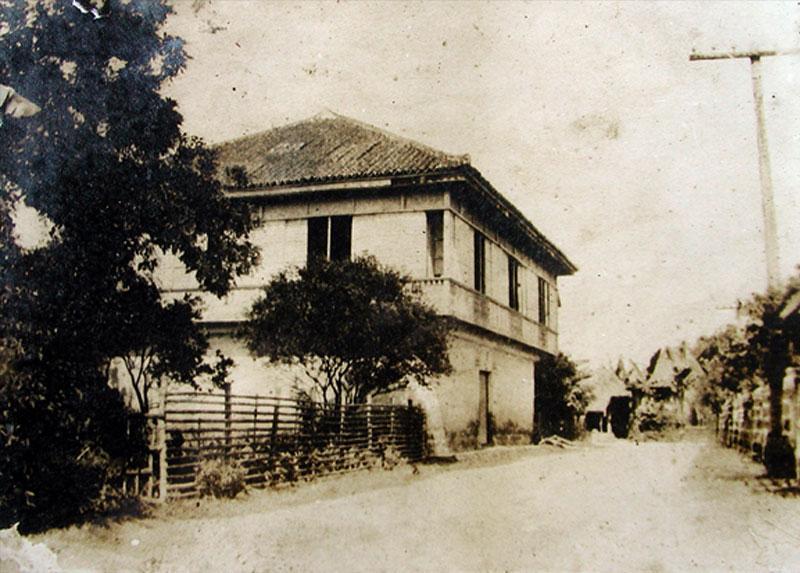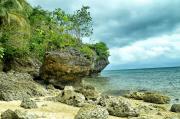
Bahay na Tisa (House of Bricks)
The City Pasig is filled not only with bounty of attractions that is potential for adventure, but it also offers a chance to experience history. The city takes pride in its rich heritage which is well-preserved throughout the years. These historical landmarks continues to fascinate visitors from all over the country because of its splendid features and significance to our history.
Bahay na Tisa (House of Bricks)
This oldest house in Pasig built by Don Cecilio Tech in 1846 has remained the home of the family over generations. One of his descendants, Dean Carlos Tech, was a noted historian who devoted hours of writing in his cozy study just above the grand staircase. After he passed away in 2001, all of the distinguished educator’s books, including original Spanish volumes, are still displayed on shelves and tables, almost as he had left them. These days, with its Spanish architecture, the house is a much-preferred shooting location for film and television.
Bitukang Manok
The waterway of Bitukang Manok is serpentine like and was a principal part of the Pasig River. The Spaniards named the river as “Rio de Pasig,” however, the people continued to refer to it among themselves as Bitukang Manok. The first sketch of Bitukang Manok or Pasig River became known as the Pariancillo River where its bank flourished as the public market up to 1970’s. Likewise, the Bitukang Manok contributed immensely to the economic prosperity of Pasig since time immemorial, by irrigating its rice plains.
The Bitukang Manok links the Pasig River with the Antipolo River. During the 17th up to the early 20th century, many pilgrims from Manila and nearby towns took the route of Bitukang Manok to the Shrine in Antipolo. Even the image of the Our Lady of Peace and Good Voyage passed this way back and forth eleven times. In the 18th century, the Gremio de Mestizos de Sangley or Chinese Mestizos built a concrete covered bridge in the style of a pagoda over this waterway. It was called Pariancillo Bridge and later, Fray Felix Trillo Bridge in honor of Pasig’s dynamic pastor.
CUARTEL DEL GUARDIA CIVIL (Guanio Residence)
This was built in 1881 by Don Apolonio Santiago y Domingo, gobernadorcillo of Pasig. In 1894, it was transformed into the Cuartel del Guardia Civil. During the outbreak of the Philippine Revolution in 1896, suspected Katipuneros were imprisoned, tortured and died here.
After the Filipino-American War, it was acquired by Doña Clara Tambunting de Oliveros and in 1922 by En gineer and Mrs. Domingo Guanio.
DIMAS-ALANG BAKERY
This is the first known bakery in Pasig which was put up in the year 1919 by Ambrosio Lozada – the father of the internationally known violinist Carmencita Lozada. The fact that it shared a pen name with national hero Dr. Jose Rizal all the more establishes its significance in the days when Pasig was starting to carve a name in entrepreneurship.
Kapasigan then, where Dimas-Alang Bakery is located, was composed of Sta. Elena, San Isidro and Wawa, the sitios by the river edge. During that time, there was nothing as enticing as the sweet scent of bread wafting all over this “baybay ng ilog”, coaxing townsfolk to pause from what they’re doing and partake of the town’s ever favorite snack: the pandesal.
In the succeeding years, Dimas-Alang would introduce baked goods inspired by foreign palates – the croissant and French breads, for example. But the Pasig folks remained loyal to the pandesal. Other favorites that saw brisk sale were the aglipay, the bonete, biscocho de cana and the “di ko akalain”.
San Antonio Abad Church - Maybunga
A distinct feature of the community is the centuries-old chapel which the Spanish missionaries, with the help of the natives of the community, built. In it is enshrined the community’s patron saint, San Antonio Abad. The patron saint is believed to help the residents in many ways, such as in bringing about a good rice harvest, progress and prosperity.
PINAGBUHATAN SAN SEBASTIAN CHURCH
From a small chapel, a bigger church was built in Pinagbuhatan. It was inaugurated on 6 May 1990 by His Eminence Jaime Cardinal Sin, Archbishop of Manila. In 31 May 1990, a decree was signed creating San Sebastian Church as a Parish of the Diocese of Pasig. Likewise in 12 June 1990, Rev. Fr. David Colong was solemnly installed as its first parish priest.
TRIBUNALll DE MESTIZOS
The old building of the Gremio de Mestizos was located in one corner of the Plaza Rizal. It became the Municipal Hall in 1959. Today, it no longer exists except in photographs and oil paintings.
The Tribunal de Mestizos or the Gremio de Mestizos was established after the Spaniards organized the Chinese population of Pasig in 1741. The tribunal is for those of mixed Spanish or Chinese ancestry. It functioned as a municipal government which performed legislative and judicial functions restricted only to members.
Plaza de Rizal
Located just across the first city hall of Pasig, Plaza Rizal stands in honor of our national hero, Dr. Jose Rizal. The plaza is also in the middle of a number of other historical sites in the area, among them, the Pasig Cathedral, the Pasig City Museum and Bahayna Tisa (House of Bricks).
Pasig Museum
This museum and art center houses the city’s historical and art treasures. Built in 1937, it was formerly known as the Concepcion Mansion, which was also a Japanese headquarters and detention house during the war. On February 19, 1945, the American flag was raised on the balcony to signal the end of Japanese occupation in Pasig. In the early 1980s, the mansion was acquired by the city government to accommodate the Pasig City Library and Museum. After its initial renovation in 2001, the museum became its sole occupant, as the Pasig Library moved to another location. The Museum has only recently undergone a second renovation as part of the administration’s objective of upholding the city’s historical and artistic legacy.
RIZAL BOY SCOUT COUNCIL HEADQUARTERS
Don Fortunato Concepcion donated the land and building of the Rizal Council Boy Scouts Headquarter. This edifice provided the prestige of the Rizal Province as the first class council and signaled a great stride in the advancement of the Scouting movement. This building was constructed in January 1949 and was completed and made ready for occupancy in one and a half month’s time.
Andres Bonifacio Monument
A cenotaph originally constructed in 1932, this monument pays tribute to the courage and leadership of the great Katipunero. Bonifacio headed the KatipunanAssemblea Magna, which launched the revolution known among local historians as Nagsabado.
Bahay Kuwago
This venue for clandestine meetings of the Katipuneroswas a hollow among thickets where ULTRA’s amphitheater now lies. It is interesting to find a trace of history where modern edifices such as a sports complex and an international school have risen.
Immaculate Conception Cathedral
In 1587, the Immaculate Conception became the patroness of the Augustinian convent in Pasig. This cathedral held various treasures, among them the “Retablo,” which depicted an almost tropical motif, with palm trees and wells, and included the basic structure of the old church of Pasig – the dome and the tower – formerly known as “Solomon’s Temple.”
It was during the celebration of the Feast of the Immaculate Conception in 1941 that former Mayor CiprianoRaymundo halted the procession to announce the bombing of Pearl Harbor.
--- :)
Nurturing your mind in the great history of Pasig is a good stuff. Visit the city and feel their living museum of spirited past.
Getting around
For a reluctant tourist, the optimal way of going about the city may be hopping into a cab and allowing it to take you on a perfunctory tour. On the other hand, going by any of the public transports available affords you a full experience of Pasig City, teeming with culture and heritage.
On EDSA, you can either take the bus – both northbound and southbound buses stop in front of Robinson’s Galleria, a perfect place to start – or the Metro Rail Transit. The MRT stops at the Ortigas Station from which Robinson’s Galleria is but a leisurely stroll. From Galleria, navigating the rest of Ortigas Center’s “jewel” streets on foot is best.
The quintessentially Filipino ride known as the “jeepney” goes the Pasig-Quiapo (and vice versa) route, which has existed for decades, and travels from the western side of Shaw Boulevard. The modern and cooler spin-off of the jeepney – the “FX” - is available at a terminal on the north side of Robinson’s Galleria.
Here are some well-known accommodations around the city that will give you comfortable nights that will fit your budget
• Astoria Plaza Suites Manila - 15 J. Escriva Drive, Ortigas Business District Pasig City, Ortigas-Pasig, Manila, Philippines
• Crowne Plaza - Ortigas Ave. Corner Asian Dev Quezon City Philippines, Ortigas-Pasig, Manila, Philippines 1100
• Discovery Suites - 25 ADB Avenue Ortigas Center, Ortigas-Pasig, Manila, Philippines 1600
• Holiday Inn - One Asian Development Bank Avenue, Ortigas Center, Ortigas-Pasig, Manila, Philippines 1655
• Linden Suites - 37 San Miguel Avenue, Ortigas Center, Ortigas-Pasig, Manila, Philippines 1600
• Richmonde Hotels - 21 San Miguel Avenue Ortigas Center, Ortigas-Pasig, Manila, Philippines 1600
• Motorist Hotels and Inns - 2149 A. Luna Street, Pasay Airport Area, Manila, Philippines










